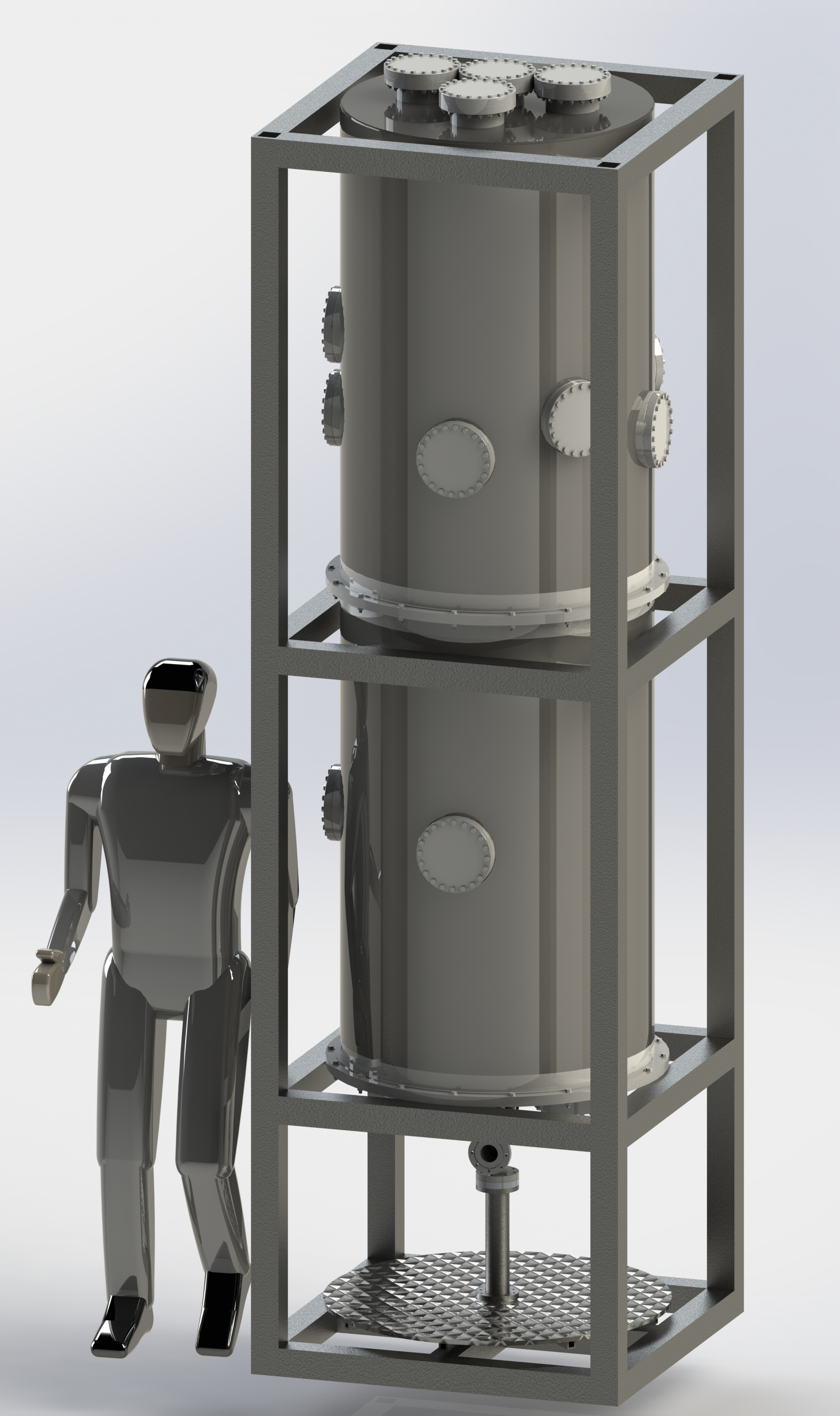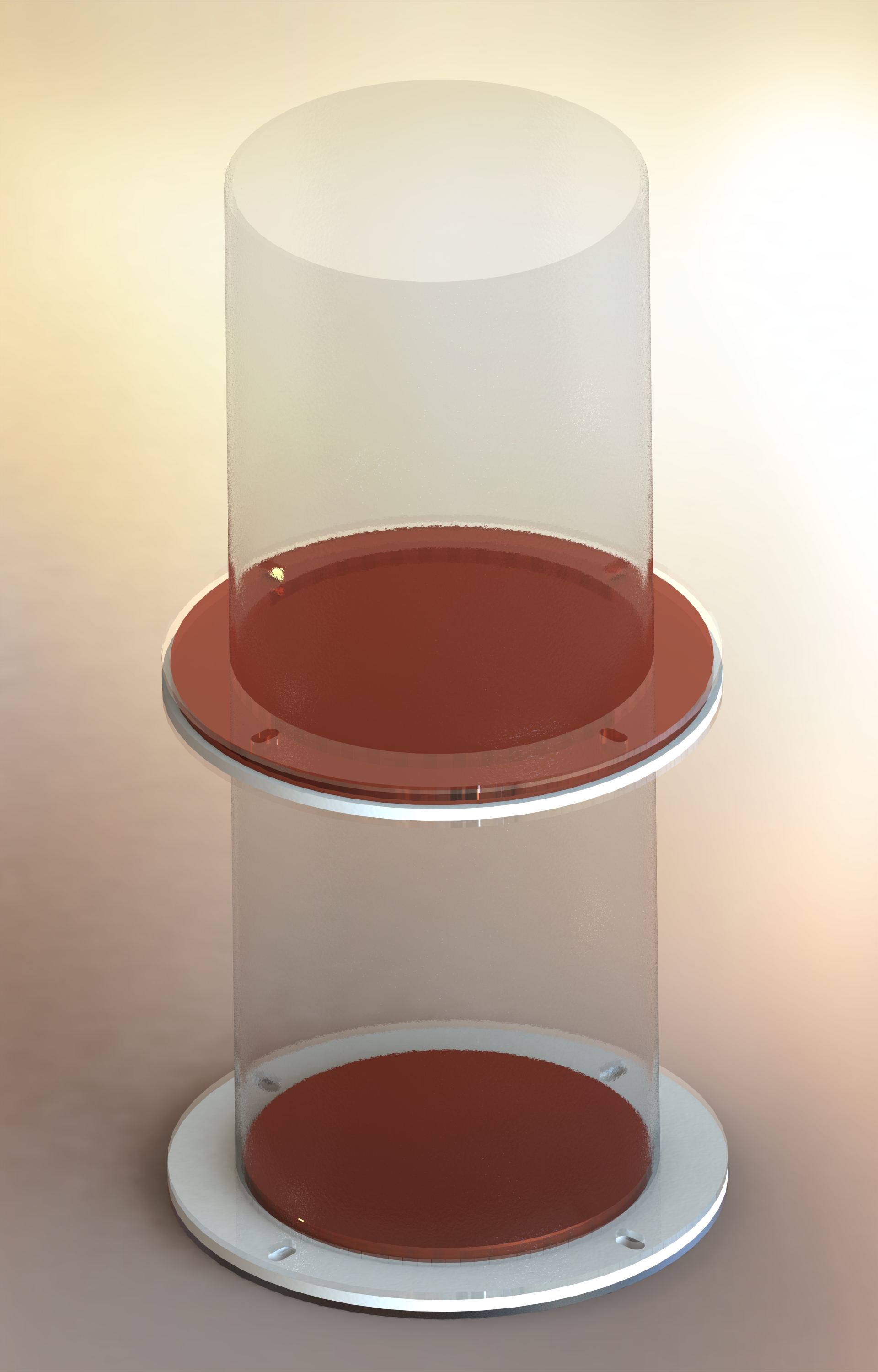Facilities ![]() Rayleigh-Benard Convection
Rayleigh-Benard Convection
STAML is designing two Rayleigh-Benard Convection (RBC) facilities at Georgia Tech.
A small scale experiment is underway to determine the effect container shape has on the flow structures in RBC in a viscous fluid. Silicone oil with viscosity of 1000 cSt is used as the working fluid. An electrical resistance Kapton film heater is used to provide heating to the bottom of the test cell. The top of the test cell is cooled by a water bath. Copper plates on the top and bottom provide uniform boundary temperatures to the fluid. The sidewalls are made of acrylic for optical access. Photochromic dye is seeded in the silicone oil to enable visualization. When irradiated with a 405 nm laser, the photochromic dye changes from clear to a bluish color for a short time. Qualitative observations about the flow structure are made.
Thermistors are imbeded in the copper plates to measure temperatures for property purposes, as well as control the heat introduced by the film heater to maintain a constant temperature. The image seen to the right depicts the 6in diameter round cell, which will be compared with an equivalent 6in square prism cell.
 A much larger cryogenic nitrogen pressure vessel is being designed to study thermally driven convection over a wide range of conditions, including regimes of extreme turbulence. Nitrogen gas near its critical point (126 K and 34 bar) is pressurized in an acrylic test cylinder. The test cylinder is a seperate chamber within the high pressure vessel to minimize the heat lost or introduced through the sidewalls. A vacuum jacket surrounds the high pressure chamber in order to minimize heat gain from the environment. The bottom of the cylinder is heated by an electrical resistance Kapton film heater. The top of the cylinder is cooled by a liquid nitrogen bath maintained at a constant temperature by a cryocooler.The height of the test cylinder is variable up to a maximum height of 6 ft. At its maximum height, heat transfer will be studied up to Rayleigh number 1017. The test chamber rests on a rotating platform, enabling the study of rotating thermally driven convection at rotation rates up to 1 Hz. All instrumentation and control wires can be routed through a rotating, high pressure feed-through port at the base of the pressure vessel. Data acquisition and controlling electronics are mounted to a co-rotating platform below the pressure vessel to eliminate noise which would result from signals passing through electrical slip rings or equivalent devices.
A much larger cryogenic nitrogen pressure vessel is being designed to study thermally driven convection over a wide range of conditions, including regimes of extreme turbulence. Nitrogen gas near its critical point (126 K and 34 bar) is pressurized in an acrylic test cylinder. The test cylinder is a seperate chamber within the high pressure vessel to minimize the heat lost or introduced through the sidewalls. A vacuum jacket surrounds the high pressure chamber in order to minimize heat gain from the environment. The bottom of the cylinder is heated by an electrical resistance Kapton film heater. The top of the cylinder is cooled by a liquid nitrogen bath maintained at a constant temperature by a cryocooler.The height of the test cylinder is variable up to a maximum height of 6 ft. At its maximum height, heat transfer will be studied up to Rayleigh number 1017. The test chamber rests on a rotating platform, enabling the study of rotating thermally driven convection at rotation rates up to 1 Hz. All instrumentation and control wires can be routed through a rotating, high pressure feed-through port at the base of the pressure vessel. Data acquisition and controlling electronics are mounted to a co-rotating platform below the pressure vessel to eliminate noise which would result from signals passing through electrical slip rings or equivalent devices.
An array of temperature sensors are embedded in copper plates at the top and bottom of the test cylinder. The temperature difference and mean temperature are controlled to specify properties of the fluid. The heat transfer rate is computed using a four-wire measurement from the film heater on the bottom, assuming all heat flows through the test cylinder. Other arrays of temperature sensors can be suspended inside the test cylinder for more detailed heat transfer information. Visualization of the flow structure in high Ra Rayleigh-Benard Convection will be done for the first time. A series of ports on the sides of the pressure vessel can be replaced with optical windows for external imaging. Frozen particles will be seeded into the test cylinder as tracer particles for particle image velocimetry (PIV), particle tracking velocimetry (PTV), and/or planar laser-induced fluorescence (PLIF).

